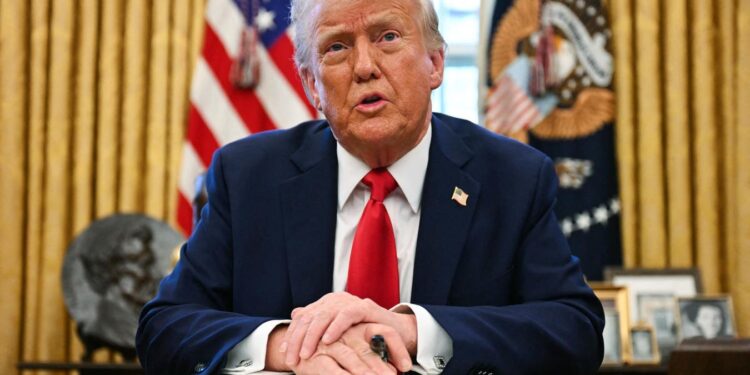Trump’s proposed sovereign wealth fund and his energy initiatives have the potential to intersect in … [+] an unexpected manner.
AFP via Getty Images
The world has been transfixed by America’s clumsy quest for energy security. In the last few weeks alone, the US has transactionalized its Ukrainian policy by demanding critical minerals as payment support, rationalized statements about Greenland by pointing to its untapped energy potential, and renewed hostility in the critical minerals front of the Sino-American trade war. Whatever one thinks of America’s current diplomatic posture, two things are clear: America is looking for anywhere for energy security, and energy security is no longer just hydrocarbons.
In the same way, all economic activity and much political intrigue revolved around hydrocarbons in the 20th century, and similar dynamics will dominate critical minerals during this century. These minerals are numerous and enable everything vital for the energy transition, modern computing, and modern militaries.
It would be a mistake to assume America’s obsession with energy independence stems solely from Trump’s blustering. The United States has pursued this policy for years, revamping its foreign aid strategy to compete with China via the Lobito Corridor to access African resources in Angola, the DRC, and Zambia. America is also not alone; the EU is making numerous forays into Africa while the UK’s search for critical minerals pushed Rainbow Rare Earths to the Phalaborwa project in South Africa and the Gakara project in Burundi. There is tremendous incentives for investment in critical minerals.
Right now, there is nowhere more important to watch than Eurasia for this energy competition and as an emerging market. The global island isn’t just a geopolitical cauldron – it also has incredible mineral deposits in Kazakhstan and Ukraine. These two states are hotbeds of political rivalries and investment opportunities. It is vital for investors and policymakers to understand these two arenas for the energy transition to be fully comprehended.
Eurasian mines like this (pictured: Sepnogo, Kazakhstan) are vital for the energy transition and … [+] destined to receive a new lease on life.
Getty Images
Ukraine
Ukraine’s mineral wealth is conservatively estimated in the trillions. This mineral wealth could be invaluable for maintaining or even upscaling American support to Kyiv, creating a practical political solution for the controversy of supporting Ukraine amongst some in the West. Ukrainian critical minerals have multiple non-geopolitical positives. Ukraine’s history of heavy industry and refining means critical minerals can easily slide into Ukrainian supply chains. Ukraine’s adjacency to a minerals-hungry Europe gives it an immediate market but also quelches local competition due to lower labor costs.
Critical minerals could also be vital to Ukrainian reconstruction and help reduce reconstruction costs for European, American, and Ukrainian citizens. As I previously argued, any Ukrainian reconstruction plan must be more like a scalpel than a sledgehammer to decisively cut and prod reform in the Ukrainian state to ensure its long-term fiscal health and Western political support. This means Western policymakers must be serious about insisting on Ukrainian anti-corruption measures, Ukrainian economic liberalization, decentralizing initiatives, and meaningful regional government. This is a tall order, and even in ideal circumstances, developing Ukrainian critical minerals will take years. Geopolitical and physical burdens will ensure that, while Ukraine has tremendous potential, it remains primarily theoretical for the immediate future.
Critical minerals are vital for all cutting edge green energy technologies, including solar panels … [+] (pictured: Fremont, California Solar Panel factory).
Copyright 2010 AP. All rights reserved.
Kazakhstan
Kazakhstan is host to a cornucopia of confirmed mineral deposits, either already or easily extractable. Of the 18 most important minerals identified by the British Geological Survey, 8 are already mined or easily accessible in Kazakhstan. Kazakhstan is also is strategically located along the so-called “Middle Corridor,” which links many of these deposits with many markets overland between Europe and China while bypassing Russia via the Caspian and Caucasus.
While Ukraine is more of a theoretical producer of critical minerals, Kazakhstan is already experiencing a minerals-fueled bonanza out of a recognition that this vital east-west bridge is a key component of American national interests. Kazakhstan has been upscaling critical minerals production and seeking investment for years since it identified this as a crucial economic area in the early 2020s.
Kazakhstan’s multi-vector foreign policy, which attracts Western investment to buttress its sovereignty, has enabled it to successfully counterbalance dangerous geopolitical headwinds by attracting Western investment. This means a low tax burden and a business-friendly climate: maximum personal taxes are 10%, and corporate 20%.
The US clearly hopes to build on the Central Asia Five (C5) format to expand existing relations. US Secretary of State Marco Rubio’s comments about cooperating with the region and ensuring permanent normal trade relations with Kazakhstan, shortly followed by a bipartisan bill to realize this, signals extensive American interest.
America is not alone. Across the pond, former Prime Minister Cameron recently visited Kazakhstan, and shortly after, the UK signed a roadmap for cooperation with Kazakhstan. At the same time, UK Export Finance announced it would offer financing to companies that export rare earths to the UK, including from Kazakhstan.
Darren G. Spinck, of the London-based Henry Jackson Society, has echoed these points in front of the British Parliament, arguing that the West’s prioritization of energy security will inevitably intersect with Central Asia’s policy of explicitly seeking Western investment. As a result – the West should accelerate its push for energy security by increasing cooperation with and facilitate investment in the region while encouraging reforms in Kazakhstan.
If America wants to win the race for energy in Kazakhstan, several things are required. The West needs to pragmatically engage with Kazakhstan’s neutrality and not offer any “us or them” ultimatums – it’s a recipe for an unwinnable confrontation. The West should also encourage recent Kazakh reforms, which, much like Ukrainian ones, stress decentralization. This makes the creation of transnational expert cooperation groups, such as between universities or the Kazakh ministries of Industry and Construction with Western counterparts, more promising.
High-level cooperation needs to be expanded as well. No American president (unlike Britain) has visited Central Asia despite its geoeconomic importance. Higher level cooperation should ideally lead to more direct FDI and reciprocal cooperation. Ideally, this would enable entities like the DFC or BII to overcome domestic roadblocks and expand infrastructure projects in Kazakhstan related to mineral extraction and the Middle Corridor. Combining this high-level diplomacy with things like more scholarships, easier visa access, and recognition of complying with sanctions would go a long way in advancing Western interests.
A New Opportunity
Ukraine and Kazakhstan are two frontier markets that, thanks to geography and politics, are bound to be at the forefront of the global energy transition. Their demand and political centrality provide an excellent opportunity for America’s nascent sovereign wealth fund proposed by President Trump.
In Ukraine, which has proposed a sovereign wealth fund, the US could cooperate to set up a joint enterprise to manage Ukrainian and American assets and future investments. This would provide a regularized investment framework backed by American political clout that would not only serve American interests but speed up desired policy outcomes and reconstruction in Ukraine.
Kazakhstan’s sovereign wealth fund, Samruk Kazyna, is already trying to spur reciprocal investment and technology transfers by investing Kazakhstan’s oil profits in the West. In return, investors are being steered towards projects of interest, such as critical minerals, expansion of energy infrastructure along the Middle Corridor, such as in the ports of Aktaku and Kuryk, and other hard infrastructure projects. This provides a prominent area of cooperation and a convenient vehicle of investment for America’s emerging fund.
America’s sovereign wealth fund, if it materializes, will have risen by unorthodox means. If it wants to thrive, it must embrace similarly unorthodox tactics. This means looking to Eurasia, and the future of energy.
Source link : http://www.bing.com/news/apiclick.aspx?ref=FexRss&aid=&tid=67ad306108dd4278aa405614e46cb7c2&url=https%3A%2F%2Fwww.forbes.com%2Fsites%2Fwesleyhill%2F2025%2F02%2F12%2Famerica-and-the-west-look-to-eurasian-energy%2F&c=12963513034306417036&mkt=en-us
Author :
Publish date : 2025-02-12 09:03:00
Copyright for syndicated content belongs to the linked Source.








